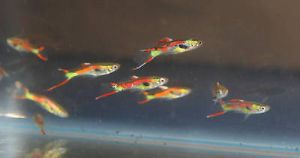
Pair Endler Guppy *2.5cm* Guppies Fish * Male + Female UK

Aquarium fish Poecilia Libestes Reticulata, often known as the Guppy, is a popular choice. It's a great choice for newbie aquarists since it's simple to care for and doesn't get in the way. In place of eggs, the Guppy, a member of the Livebearer family, will lay free swimming fry. South and Central American seas are where the Guppy comes from, although it may also be found wild in other parts of the globe, including Florida in the United States. In an effort to reduce malaria, the Guppy has been purposely released in numerous Asian waterways.
You may choose from a variety of Guppy fish models, each with a unique body form and color. Red, green, and blue are the most prevalent colors. In addition to Veiltail guppy, Lacetail guppy and Lyretail guppy, there are also Flagtail guppy, Flagtail guppy, Long fin guppy, Fantail guppy, Red tail guppy, Triangle tail guppy, Rounded guppy, Fancy Guppy, Tuxedo guppy, Glass guppy, Mosaic Guppy, King Cobra Guppy, Snakeskin guppy, and Peacock Guppy.
Guppies are popular in community aquariums because to their calm disposition. However, since other fish can attack them by biting their long fins, they prefer to be housed in species aquariums. A charming school may be created by grouping numerous Guppies together.
It's possible to keep a Guppy fish in a 2 gallon aquarium, however it's recommended that you keep more than one Guppy in a bigger aquarium. To keep the water temperature steady, you will need a heater and a thermometer, a filter, a fish net, an algae scrubber, and an air stone or similar to maintain the water oxygen-rich. Decorate the aquarium with plants so that the Guppy fish have somewhere to hide and feel more comfortable. The aquarium may also be decorated with pebbles, branches, and other natural materials. Gravel should be used to line the aquarium's bottom. To get rid of tap water's toxic chlorine taste, acquire a dechlorinating chemical from your local fish shop. Keep the pH between 6.8 and 7.6 and the water temperature between 75 and 85 degrees Fahrenheit for the greatest results with your Guppies.
Guppies need to be fed around once or twice a day at most. It's critical that you don't feed your Guppy too much. After just a few minutes, every meals should be devoured. It's possible that you're overfeeding your Guppy. Any fish shop will have flake food created specifically for tropical fish, such the Guppy. While a flake meal diet is a suitable starting point for the Guppy, live food is recommended as a supplement. Your Guppy can thrive on flake food, but live food is better for its health and well-being. Freezing or thawing Brine Shrimp is a popular meal for Guppy fish since it is simple to make at home and is extremely nutritious. Your Guppy can eat Bloodworms, Micro Worms, Fruit Flies and Mosquito larvae as well as Daphnia and cut up Earthworms.


$9.99

$30.00



